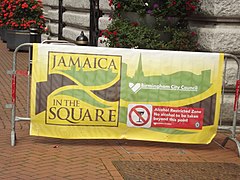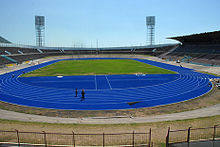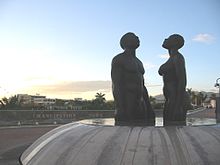Independence Day (Jamaica)
| Independence Day | |
|---|---|
 A sign for a Jamaica in the Square event in honor of Jamaican Independence Day on Chamberlain Square, Birmingham. | |
| Observed by | |
| Type | State |
| Celebrations | Fireworks, Concerts, Parades |
| Date | 6 August 1962 |
The Independence Day of Jamaica is a national holiday celebrated in Jamaica. This holiday commemorates such an event, it is one of the most senior public holidays celebrated in Jamaica.
Background
The
Jamaica also entered the
Celebrations

The main celebrations take place in the evening at the National Arena in Independence Park. On Independence Day, Jamaicans take part in huge street parades, don clothing coloured like the Jamaican flag, and put on all manner of cultural displays.[3]
The overall event is termed "
The following uniformed marching bands take part in the ceremonies:
- Jamaica Military Band
- The Jamaica Regiment Band
- Corps of Drumsof the 1st Battalion, The Jamaica Regiment
- Corps of Drums of the 3rd Battalion, The Jamaica Regiment
- Jamaica Constabulary Force Band
- Jamaica Combined Cadet Force Band
Timeline
- On the day it gained its independence, the Jamaican flag, firstly in the capital and then around the nation. Princess Margaret the Countess of Snowdon, opened the first session of the Parliament of Jamaica on behalf of her sister the Queen.[7]
- Emancipation Park was opened days before Independence Day and on the eve of Emancipation Day in 2002.[8][9]
- In 2012, reggae singer Tappa Zukie.[10]
- A 50th anniversary military tattoo, dubbed the Jamaica Military Tattoo 2012, was held between 28 June to 1 July at the JDF Polo Field at Up Park Camp.[11] The tattoo saw members of the Jamaica Military Band, the Jamaica Constabulary Force Band and the Jamaica Fire Brigade Band take part.
- In 2019, Kenyan President Uhuru Kenyatta attended the 57th Independence anniversary celebrations as part of a three-day state visit to Jamaica as a guest of Prime Minister Andrew Holness.
Relations with Emancipation Day

Emancipation Day is another public holiday that is part of a week-long cultural celebration starting on 1 August and ending on Independence Day. It commemorates the Emancipation of the British West Indies in the 1830s and the Slavery Abolition Act of 1833. Having been a national holiday under British control, Emancipation Day had stopped being observed as a national holiday in 1962 after independence.[12] It was reinstated as a national public holiday in 1998 after a six-year campaign led by Jamaican scholar and educational leader Rex Nettleford.[13][14]
Traditionally, people hold
References
- ^ "Historian situates 'back-to-Africa' movements in broad context". 1 March 2006. Stanford.edu. March 2006. Retrieved 24 August 2013.
- ^ "Jamaica: Self-government". Encyclopædia Britannica. Retrieved 24 August 2013.
- ^ McLeod, Sheri-Kae (2019-07-31). "How Jamaicans Are Celebrating Jamaica's Emancipation Day & 57th Independence Day". Caribbean News. Retrieved 2021-07-20.
- ^ "Independence Day 2021, 2022 and 2023 in Jamaica". PublicHolidays.la. Retrieved 2021-07-20.
- ^ ISBN 0-87930-655-6.
- ^ Rebecca Tortello (July 2002). "The History of Jamaica Festival". The Gleaner. Retrieved 10 February 2008.
- ^ "A Special Gleaner Feature on Pieces of the Past". 2001. Jamaica-Gleaner. Archived from the original on 18 June 2013. Retrieved 24 August 2013.
- ^ "The History of Emancipation Day". Trinidad and Tobago Newsday. 1 August 2012. Retrieved 11 August 2016.
- ^ "The Development of Emancipation Park". Emancipation Park Jamaica. Retrieved 11 August 2016.
- ^ "Interview: Dennis Alcapone and Winston Reedy | United Reggae". unitedreggae.com. Retrieved 2021-07-20.
- ^ "JDF to Host Colourful Military Tattoo – Jamaica Information Service". jis.gov.jm. Retrieved 2021-07-24.
- ISBN 9781136667381. Retrieved 11 August 2016.
- ^ "How we celebrate Emancipation Day". Emancipation Park, Jamaica. Retrieved 11 August 2016.
- ^ "Holidays (Public General) Act". Ministry of Justice. Retrieved 11 August 2016.
- ISBN 9780778793328.
